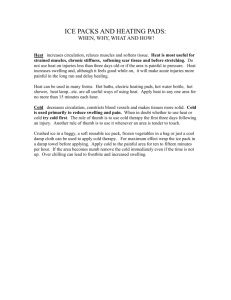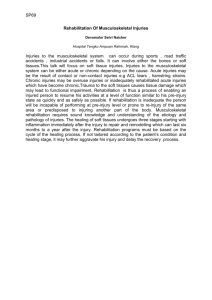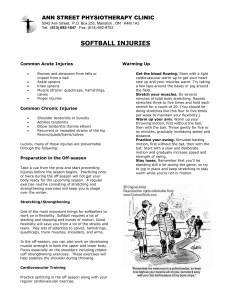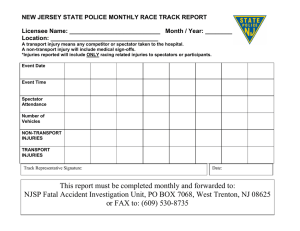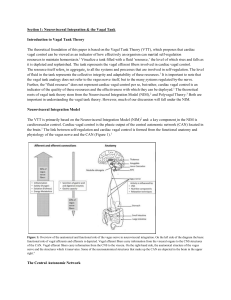Major Factors Associated With Injuries To Runners
advertisement
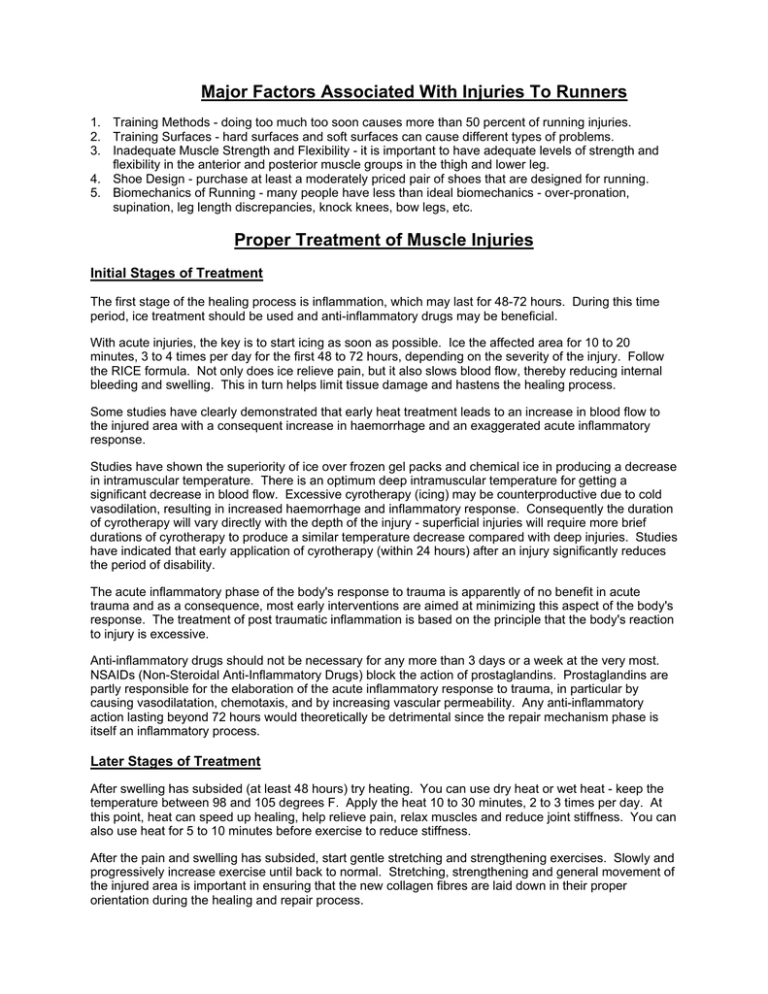
Major Factors Associated With Injuries To Runners 1. Training Methods - doing too much too soon causes more than 50 percent of running injuries. 2. Training Surfaces - hard surfaces and soft surfaces can cause different types of problems. 3. Inadequate Muscle Strength and Flexibility - it is important to have adequate levels of strength and flexibility in the anterior and posterior muscle groups in the thigh and lower leg. 4. Shoe Design - purchase at least a moderately priced pair of shoes that are designed for running. 5. Biomechanics of Running - many people have less than ideal biomechanics - over-pronation, supination, leg length discrepancies, knock knees, bow legs, etc. Proper Treatment of Muscle Injuries Initial Stages of Treatment The first stage of the healing process is inflammation, which may last for 48-72 hours. During this time period, ice treatment should be used and anti-inflammatory drugs may be beneficial. With acute injuries, the key is to start icing as soon as possible. Ice the affected area for 10 to 20 minutes, 3 to 4 times per day for the first 48 to 72 hours, depending on the severity of the injury. Follow the RICE formula. Not only does ice relieve pain, but it also slows blood flow, thereby reducing internal bleeding and swelling. This in turn helps limit tissue damage and hastens the healing process. Some studies have clearly demonstrated that early heat treatment leads to an increase in blood flow to the injured area with a consequent increase in haemorrhage and an exaggerated acute inflammatory response. Studies have shown the superiority of ice over frozen gel packs and chemical ice in producing a decrease in intramuscular temperature. There is an optimum deep intramuscular temperature for getting a significant decrease in blood flow. Excessive cyrotherapy (icing) may be counterproductive due to cold vasodilation, resulting in increased haemorrhage and inflammatory response. Consequently the duration of cyrotherapy will vary directly with the depth of the injury - superficial injuries will require more brief durations of cyrotherapy to produce a similar temperature decrease compared with deep injuries. Studies have indicated that early application of cyrotherapy (within 24 hours) after an injury significantly reduces the period of disability. The acute inflammatory phase of the body's response to trauma is apparently of no benefit in acute trauma and as a consequence, most early interventions are aimed at minimizing this aspect of the body's response. The treatment of post traumatic inflammation is based on the principle that the body's reaction to injury is excessive. Anti-inflammatory drugs should not be necessary for any more than 3 days or a week at the very most. NSAIDs (Non-Steroidal Anti-Inflammatory Drugs) block the action of prostaglandins. Prostaglandins are partly responsible for the elaboration of the acute inflammatory response to trauma, in particular by causing vasodilatation, chemotaxis, and by increasing vascular permeability. Any anti-inflammatory action lasting beyond 72 hours would theoretically be detrimental since the repair mechanism phase is itself an inflammatory process. Later Stages of Treatment After swelling has subsided (at least 48 hours) try heating. You can use dry heat or wet heat - keep the temperature between 98 and 105 degrees F. Apply the heat 10 to 30 minutes, 2 to 3 times per day. At this point, heat can speed up healing, help relieve pain, relax muscles and reduce joint stiffness. You can also use heat for 5 to 10 minutes before exercise to reduce stiffness. After the pain and swelling has subsided, start gentle stretching and strengthening exercises. Slowly and progressively increase exercise until back to normal. Stretching, strengthening and general movement of the injured area is important in ensuring that the new collagen fibres are laid down in their proper orientation during the healing and repair process.
